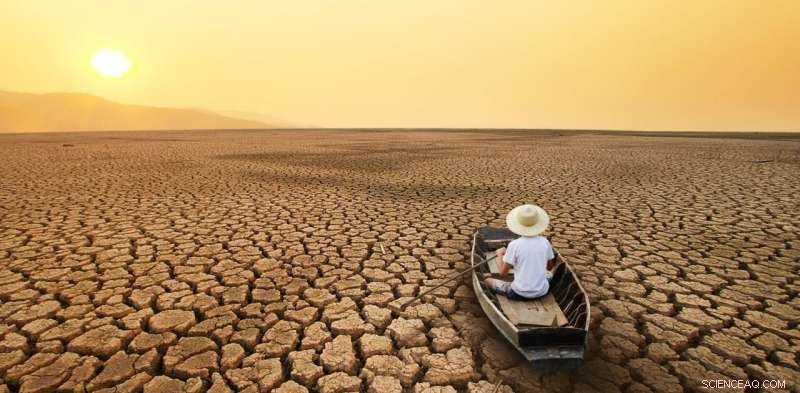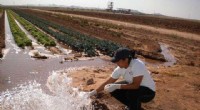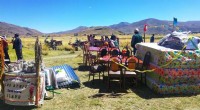Hvordan politik, ikke klimaændringer, er ansvarlig for katastrofer og konflikter

Kredit:Piyaset / shutterstock
Den seneste FN-rapport om de potentielle virkninger af klimaændringer giver en dyster dom, med nogle virkninger, der nu anses for at være uundgåelige. Men der er også lektioner om katastrofer og voldelige konflikter, som kan hjælpe med at redde liv og skabe sikrere samfund uanset menneskeskabte klimaændringer.
Den vigtigste tilgængelige tekst til rapporten fra Intergovernmental Panel on Climate Change (IPCC) om "Impacts, Adaptation and Vulnerability" er et 35-siders resumé for politiske beslutningstagere, som ifølge IPCC's regler er godkendt af medlemslandenes regeringer.
IPCC-forskere er udpeget af medlemslandene, og disse bidragende forskere producerer ikke ny videnskab. De opsummerer titusindvis af peer-reviewede videnskabelige artikler om klimaændringer siden den forrige vurdering (den sidste store IPCC-rapport om påvirkninger, tilpasning og sårbarheder blev offentliggjort i 2014).
Forskerne modtager derefter tusindvis af anmeldelseskommentarer på udkast, der kræver tekstrevisioner eller svar. I forbindelse med en række udsagn om vores forståelse af klimaændringer tildeler rapporten tillidsniveauer som "lavt" eller "meget højt" for at angive, hvor sikre forfatterne er af hver enkelt.
Den nuværende rapport er blevet overskygget af ukrainske videnskabsmænd, der måtte forlade godkendelsessessionen for at tage sig af sig selv og deres familier under Ruslands invasion af deres land. Ikke desto mindre har omkring 90 videnskabsmænd fra alle beboede kontinenter og balanceret mellem kvinder og mænd udarbejdet dokumentet. Som det ofte sker, dukkede der rapporter op om politiske fremstød for at fjerne videnskabeligt indhold, som understreger materialets politiske karakter.
Katastrofer og klimaændringer
Som en akademiker, der forsker i katastrofer og sundhed, var jeg især interesseret i, hvordan rapporten undersøgte klimaændringer som en årsag til katastrofer, herunder voldelige konflikter, og opstillede handlinger for at undgå dem.
IPCC's resumé undgår fuldstændigt udtrykket "naturkatastrofe". Dette afspejler årtiers arbejde med at forklare, at katastrofer er forårsaget af kilder til sårbarhed – såsom ulige og ulige adgang til væsentlige tjenester som sundhedspleje eller dårligt designet eller bygget infrastruktur som kraftværker – snarere end af klimaet eller andre miljøpåvirkninger.
Rapporten fastslår med stor tillid, at "klimaændringer bidrager til humanitære kriser, hvor klimafarer interagerer med høj sårbarhed." Der skal med andre ord eksistere en sårbarhed, før en krise kan opstå. Klimaændringer er ikke årsagen til katastrofer. The report explains that places with "poverty, governance challenges and limited access to basic services and resources, violent conflict and high levels of climate-sensitive livelihoods" are more vulnerable to climate change impacts.

Mozambique is one of the world’s most vulnerable countries, according to the Climate Risk Index. Credit:fivepointsix / shutterstock
For example, cyclones still lead to disasters in Bangladesh. Nevertheless, the country has substantially reduced deaths and damage through concerted efforts to reduce vulnerabilities. These include building thousands of storm shelters and issuing early warnings by multiple means. These measures have made cyclones less deadly even as the storms have become more intense due to climate change.
Weather disasters which kill more people tend to occur where communities and infrastructure are more vulnerable, according to the report. Heat is rightly highlighted as a major concern, since it causes crops to fail and forces people to halt work. That said, it is surprising that the health impacts of humidity, which can combine with extreme heat to deadly effect, are not mentioned.
The report explains that disaster risk and impacts can be reduced by tackling fundamental issues which cause vulnerability, no matter what the weather and climate do. It places high confidence in risk management, risk sharing, and warning strategies as key tasks for adapting to climate change.
Violent conflict and climate change
As with disasters, the report cannot attribute violent conflict to climate change. With high confidence, the report states that "compared to other socioeconomic factors the influence of climate on conflict is assessed as relatively weak." This corroborates other research which argues peace and conflict are more determined by social and political factors than by climate or weather.
The authors identify, with high confidence, actions to reduce the "underlying vulnerabilities" which raise the risk of violent conflict. These can be based on research and might include redistributing wealth and resources to make societies more equal and equitable, while providing diverse livelihoods. Adapting to climate change is only part of the solution. Scientific analyses note how development, rather than climate change adaptation only, is the most effective overall.
In fact, despite frequent assumptions that climate change caused or was linked to violent conflicts in the past, the summary implies that no single conflict should be attributed to climate change, natural or anthropogenic. This conclusion matches analyses for Darfur in 2003 and Syria in 2011.
Summary of the summary
The IPCC's press release on the new report was headlined "Climate change:a threat to human wellbeing and health of the planet." Its stark opening detailed "dangerous and widespread disruption." Yet its subtitle, "Taking action now can secure our future," needs emphasizing. This is particularly the case for disasters and violent conflicts which, the summary document states with high confidence, are not significantly influenced by human-caused climate change.
Perhaps the press release mentions neither disasters nor violent conflict because they represent comparatively positive news among the bleakness. Ultimately, "taking action now" means applying the science of disasters and conflict for prevention. Then, we save lives and livelihoods, no matter what climate change does.
Sidste artikelHvordan påvirker marine gasser skydannelsen?
Næste artikelHvordan et marinkemilaboratorium reducerede deres CO2-fodaftryk
 Varme artikler
Varme artikler
-
 Overvågning i Big Brother-stil giver nyt indblik i Amazons skjulte dyrelivSolnedgang ved Mamiraua -floden ved Mamiraua -reservatet, Brasiliens største beskyttede område, i staten Amazonas:forskere aflytter nu skovens dyreliv ved hjælp af meget følsomme lytteapparater Fo
Overvågning i Big Brother-stil giver nyt indblik i Amazons skjulte dyrelivSolnedgang ved Mamiraua -floden ved Mamiraua -reservatet, Brasiliens største beskyttede område, i staten Amazonas:forskere aflytter nu skovens dyreliv ved hjælp af meget følsomme lytteapparater Fo -
 Bedre vandtest, mere sikre produkterEn kandidatstuderende ved University of Arizona samler en vandprøve fra et kunstvandingssystem. Kredit:Natalie Brassill, University of Arizona. Salater var for nylig i nyhederne - og uden for Amer
Bedre vandtest, mere sikre produkterEn kandidatstuderende ved University of Arizona samler en vandprøve fra et kunstvandingssystem. Kredit:Natalie Brassill, University of Arizona. Salater var for nylig i nyhederne - og uden for Amer -
 Bedre end penge? Naturalydelser tilskynder landmændene til at bevare agrobiodiversitetenLandmændenes belønninger inkluderede madrasser, landbrugsforsyninger, og andre nyttige ting. Kredit:A.Drucker Hvad hvis du modtog en ny madras i bytte for at plante forskellige afgrøder? Det lyder
Bedre end penge? Naturalydelser tilskynder landmændene til at bevare agrobiodiversitetenLandmændenes belønninger inkluderede madrasser, landbrugsforsyninger, og andre nyttige ting. Kredit:A.Drucker Hvad hvis du modtog en ny madras i bytte for at plante forskellige afgrøder? Det lyder -
 Hvordan omdannes nuklear fission til elektrisk energi?Den effekt, der kan produceres ved vand, der ekspanderer til damp, er blevet kontrolleret og brugt i hundredvis af år. I en atomreaktor er denne reaktion forårsaget af den varme, der genereres i forbi
Hvordan omdannes nuklear fission til elektrisk energi?Den effekt, der kan produceres ved vand, der ekspanderer til damp, er blevet kontrolleret og brugt i hundredvis af år. I en atomreaktor er denne reaktion forårsaget af den varme, der genereres i forbi
- Biologer skaber bille med funktionelt ekstra øje
- Insiderhandel er blevet mere subtil
- Materialer til den næste generation af elektronik og fotovoltaik
- Kunne vi genbruge plastikposer til fremtidens stoffer?
- Pandemi tilbyder pause, ikke ende, til globaliseringen
- Et sort hul eller to? Støvskyer kan forklare forvirrende træk ved aktive galaktiske kerner


